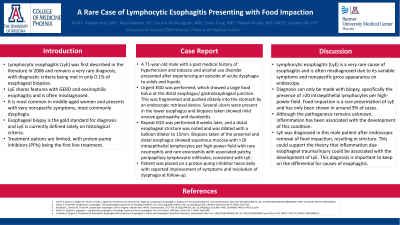Back


Poster Session E - Tuesday Afternoon
Category: Esophagus
E0234 - A Rare Case of Lymphocytic Esophagitis Presenting With Food Impaction
Tuesday, October 25, 2022
3:00 PM – 5:00 PM ET
Location: Crown Ballroom

Has Audio

Kelli C. Kosako Yost, MD
University of Arizona College of Medicine
Phoenix, AZ
Presenting Author(s)
Kelli C. Kosako Yost, MD1, Majd Aboona, BS1, Paul A. Muna Aguon, MD2, Brian M. Fung, MD1, Rakesh Nanda, MD, FACG3, Qumber Ali, DO4
1University of Arizona College of Medicine, Phoenix, AZ; 2University of Arizona, Phoenix, AZ; 3Phoenix VA Health Care System, Phoenix, AZ; 4University of Arizona College of Medicine - Phoenix Internal Medicine Residency, Phoenix, AZ
Introduction: Lymphocytic esophagitis (LyE) was first described in the literature in 2006 and remains a very rare diagnosis, with diagnostic criteria being met in only 0.1% of esophageal biopsies. LyE shares features with GERD and eosinophilic esophagitis and is often misdiagnosed. It is most common in middle-aged women and presents with very nonspecific symptoms, most commonly dysphagia. Esophageal biopsy is the gold standard for diagnosis and LyE is currently defined solely on histological criteria. Treatment options are limited, with proton-pump inhibitors (PPIs) being the first line treatment.
Case Description/Methods: A 71-year-old male with a past medical history of hypertension and tobacco and alcohol use disorder presented after experiencing an episode of acute dysphagia to solids and liquids. Urgent EGD was performed, which showed a large food bolus at the distal esophagus/gastroesophageal junction. This was fragmented and pushed distally into the stomach by an endoscopic retrieval device. Several ulcers were present in the lower esophagus and biopsies taken showed mild erosive gastropathy and duodenitis. Repeat EGD was performed 8 weeks later, and a distal esophageal stricture was noted and was dilated with a balloon dilator to 15mm. Biopsies taken of the proximal and distal esophagus showed squamous mucosa with >20 intraepithelial lymphocytes per high-power field with rare neutrophils and rare eosinophils with associated patchy, peripapillary lymphocytic infiltrates, consistent with LyE. Patient was placed on a proton-pump inhibitor twice daily with reported improvement of symptoms and resolution of dysphagia at follow-up.
Discussion: Lymphocytic esophagitis (LyE) is a very rare cause of esophagitis and is often misdiagnosed due to its variable symptoms and nonspecific gross appearance on endoscopy. Diagnosis can only be made with biopsy, specifically the presence of >20 intraepithelial lymphocytes per high-power field. Food impaction is a rare presentation of LyE and has only been shown in around 9% of cases. Although the pathogenesis remains unknown, inflammation has been associated with the development of this condition. LyE was diagnosed in this male patient after endoscopic removal of food impaction, resulting in stricture. This could support the theory that inflammation due esophageal trauma/injury could be associated with the development of LyE. This diagnosis is important to keep on the differential for causes of esophagitis.
Disclosures:
Kelli C. Kosako Yost, MD1, Majd Aboona, BS1, Paul A. Muna Aguon, MD2, Brian M. Fung, MD1, Rakesh Nanda, MD, FACG3, Qumber Ali, DO4. E0234 - A Rare Case of Lymphocytic Esophagitis Presenting With Food Impaction, ACG 2022 Annual Scientific Meeting Abstracts. Charlotte, NC: American College of Gastroenterology.
1University of Arizona College of Medicine, Phoenix, AZ; 2University of Arizona, Phoenix, AZ; 3Phoenix VA Health Care System, Phoenix, AZ; 4University of Arizona College of Medicine - Phoenix Internal Medicine Residency, Phoenix, AZ
Introduction: Lymphocytic esophagitis (LyE) was first described in the literature in 2006 and remains a very rare diagnosis, with diagnostic criteria being met in only 0.1% of esophageal biopsies. LyE shares features with GERD and eosinophilic esophagitis and is often misdiagnosed. It is most common in middle-aged women and presents with very nonspecific symptoms, most commonly dysphagia. Esophageal biopsy is the gold standard for diagnosis and LyE is currently defined solely on histological criteria. Treatment options are limited, with proton-pump inhibitors (PPIs) being the first line treatment.
Case Description/Methods: A 71-year-old male with a past medical history of hypertension and tobacco and alcohol use disorder presented after experiencing an episode of acute dysphagia to solids and liquids. Urgent EGD was performed, which showed a large food bolus at the distal esophagus/gastroesophageal junction. This was fragmented and pushed distally into the stomach by an endoscopic retrieval device. Several ulcers were present in the lower esophagus and biopsies taken showed mild erosive gastropathy and duodenitis. Repeat EGD was performed 8 weeks later, and a distal esophageal stricture was noted and was dilated with a balloon dilator to 15mm. Biopsies taken of the proximal and distal esophagus showed squamous mucosa with >20 intraepithelial lymphocytes per high-power field with rare neutrophils and rare eosinophils with associated patchy, peripapillary lymphocytic infiltrates, consistent with LyE. Patient was placed on a proton-pump inhibitor twice daily with reported improvement of symptoms and resolution of dysphagia at follow-up.
Discussion: Lymphocytic esophagitis (LyE) is a very rare cause of esophagitis and is often misdiagnosed due to its variable symptoms and nonspecific gross appearance on endoscopy. Diagnosis can only be made with biopsy, specifically the presence of >20 intraepithelial lymphocytes per high-power field. Food impaction is a rare presentation of LyE and has only been shown in around 9% of cases. Although the pathogenesis remains unknown, inflammation has been associated with the development of this condition. LyE was diagnosed in this male patient after endoscopic removal of food impaction, resulting in stricture. This could support the theory that inflammation due esophageal trauma/injury could be associated with the development of LyE. This diagnosis is important to keep on the differential for causes of esophagitis.
Disclosures:
Kelli Kosako Yost indicated no relevant financial relationships.
Majd Aboona indicated no relevant financial relationships.
Paul Muna Aguon indicated no relevant financial relationships.
Brian Fung indicated no relevant financial relationships.
Rakesh Nanda indicated no relevant financial relationships.
Qumber Ali indicated no relevant financial relationships.
Kelli C. Kosako Yost, MD1, Majd Aboona, BS1, Paul A. Muna Aguon, MD2, Brian M. Fung, MD1, Rakesh Nanda, MD, FACG3, Qumber Ali, DO4. E0234 - A Rare Case of Lymphocytic Esophagitis Presenting With Food Impaction, ACG 2022 Annual Scientific Meeting Abstracts. Charlotte, NC: American College of Gastroenterology.
